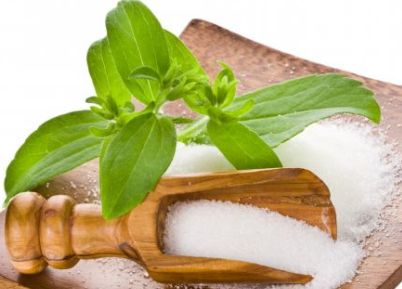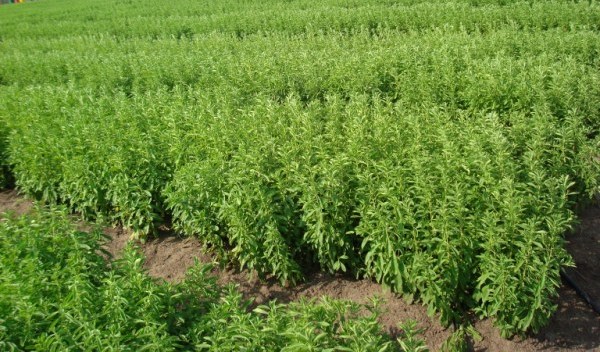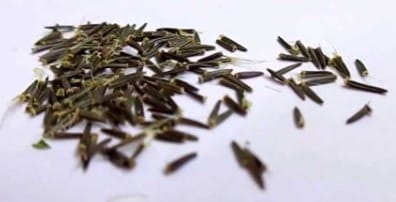Growing Stevia Information:
Introduction to Stevia:- Stevia is a small herbaceous perennial growing natural, zero-calorie, sweet tasting plant used as sugar alternative around the world. This miracle herb also being used for lowering blood pressure. The stevia plant is native to Brazil and Paraguay and is grown on a commercial scale especially in the Asian region. This plant can reach a height of 3 feet (91 cm) with slender, branched stems, and grows well all over the temperate, and some parts of tropical regions of the world. Stevia leaf extract is being used in many sugar alternative processes. Stevia is a natural sweetener to diabetics and others on carbohydrate-controlled diets. Commercial cultivation of Stevia herb is tremendously growing day by day as it has a huge demand for local and export markets because of its medicinal values. Stevia is grown on a commercial scale in China, Thailand, Paraguay, Japan, and Brazil. China tops the production Stevia in the world. However, you must understand the fact that the legal status of Stevia extracts as food additives and supplements vary from country to country. Growing Stevia plant is profitable under ideal conditions of plant science. In the following article, let us talk about more on “how to grow Stevia plant”.
Scientific Name/Botanical Name of Stevia:- Stevia rebaudiana.
Family Name of Stevia Plant:- Asteraceae.
Genus of Stevia Plant:- Stevia Cav.
World Major Production Countries of Stevia:- Paraguay, Kenya, China, United States, Vietnam, Brazil, India, Argentina, and Colombia are major countries of Stevia production.
Health Benefits of Stevia:- The following are some of the health benefits of Stevia leaves.

- Stevia aids in the management of diabetes.
- Stevia is also aids in weight loss management.
- Stevia helps to prevent a certain type of cancers.
- Stevia prevents gingivitis and cavities hence good for oral health.
- Stevia is good for skin health as it can treat eczema and dermatitis.
- Stevia also supports bone health by reducing the risk of osteoporosis.
- Stevia helps in alleviating blood pressure.
Varieties of Stevia:- Each region has a different variety of Stevia cultivar and you should find out appropriate cultivar for the region. The following are some of the varieties grown in India.
- SRB – 123.
- SRB – 512.
- SRB – 128.
Climate Requirement for Stevia Production:- When it comes to climate, Stevia crop requires on an average rainfall of 140 to 150 cm/year for good plant growth. The annual average temperature of 30°C to 32°C is ideal for its growth. However, make sure the day temperatures are not exceeding above 47°C and night temperatures are not falling below 5°C.

Soil Requirement for Stevia Production:- Though it can be grown on a wide range of soils, sandy loam, and red soils are best suited for growing Stevia crop. However, the soil pH of 6.5 to 7.5 would be ideal for its best growth and yield. It requires constant moisture of soil and it does not grow well in clayey soils and black cotton soils.
Land Preparation for Stevia Production:- Proper land preparation is very important in growing Stevia plant. The land should be plowed thoroughly with a disc plow or harrowed to break down the clods in the field. Make sure the soil is brought down to a fine tilth stage. Carry out 1 to 2 plowing after harrowing is recommended. This land preparation should also clear any unwanted weeds and stones in the field.
Propagation and Planting of Stevia:- Stevia can be propagated through seed or stem cutting and planted on beds up to 45,000 to 50,000 plants per 1 acre of field. Stem cuttings of 15 to 16 cm length should be taken from current year leaf exile for better results. The best months for the propagation of Stevia depends on the region. Generally, these cuttings will be ready for transplanting after 1 month rooting. The best and economical way to grow Stevia crop is forming raised beds. This requires raised beds height of 1/2 feet width and 1/2 feet height. The row-to-row distance is 1 foot and plant-to-plant is 1/2 feet. This measurement will accommodate around 50,000 plants/acre.

Note: Stevia crop can be grown under irrigated condition by both direct sown and transplanted methods.
Irrigation requirement for Stevia Production:- Stevia crop requires consistent soil moisture to support maximum shoot growth. Commercial farmers can adopt a drip, furrow or sprinkler applications. Drip and furrow irrigation methods are preferred for high leaf quality and to decrease the incidence of any pathogens. Avoid any water stress and watering frequency in growing Stevia depends on soil moisture holding capacity and climatic condition. Waterlogging conditions is the field should be avoided by providing water drains.
Manures and Fertilizers for Stevia:- Stevia crop responds very well to fertilizers. 30:110:110 kg/ha of N:P:K is recommended for higher yields. You can supplement the well-decomposed farmyard manure of 10 to 15 tonnes/ha during the land preparation.
Intercultural Operations of Stevia Crops:- Timely and proper intercultural operation are required in Stevia crop growing.
- Weed Control: Weed free crop is always desirable and removal of weeds should be carried out manually. Intercultural operations in Stevia crops is easy since the crop is grown in raised beds. It is not recommended to spray any chemicals for controlling the weeds as these are medicinal plants.
- Avoid Flowering: Flowering of the Stevia plants should be avoided as it has a tendency to grow tall. Pinching of the apical bud is recommended to enhance bushy growth of the Stevia plant with side branches.
Pests and Diseases of Stevia Crop:- No serious pests and diseases found in Stevia crop cultivation. However, In case if you notice any diseases, spray neem oil diluted in water. This method is best for medicinal plants to grow organically. In the case of root grubs, use castor oil mixed with cow manure and should be sprayed very little near the Stevia plants. The fungal pathogens Powdery mildew, septoria leaf spot, Alternaria leaf spot, and damping-off diseases, have been reported in some of the countries. For symptoms and control measures, see the technical officer at your local horticulture department.
Note: Your local horticulture department is a good source of finding information about pests and diseases in Growing Stevia. Don’t experiment on your own without knowing the symptoms and causes of the said pests and diseases.
Harvesting of Stevia:- Stevia crop can be harvested usually when plants attain the height of 50 cm to 60 cm. Optimum yield and quality of produce are best just prior to flowering. Harvesting of the plant leaves should be done by plucking. The entire plant with the side branches should be cut leaving 12 to 15 cm from the base.
Post-Harvest in Growing Stevia:- Depending on climatic conditions and density of loading, it takes 24 to 48 hours to dry Stevia plants at 45°C to 50°C. Immediately after drying, Thresher/Separator should be used to separate dry Stevia plant leaves from its stem. dried leaves of Stevia go through a purification process involving the extraction, filtration, and dehydration which complies with regulatory standards of the specific country.
The yield of Stevia:- Yield of Stevia crop depends on many factors such as cultivar, soil type, climate, plant age, and other crop management practices. On average, one can obtain a yield of 3 to 4 tonnes/ha dry green leaves from 4 to 5 cuttings of every year. Usually, this crop is cultivated up to 5 years after a one-time plantation.

I want a complete training of stevia farming and its processing.
Contact National Horticulture Board or your local horticulture consultants and training centers.
I am interested in contract farming of Stevia farming . Can you help me . I am from nashik , Maharashtra state